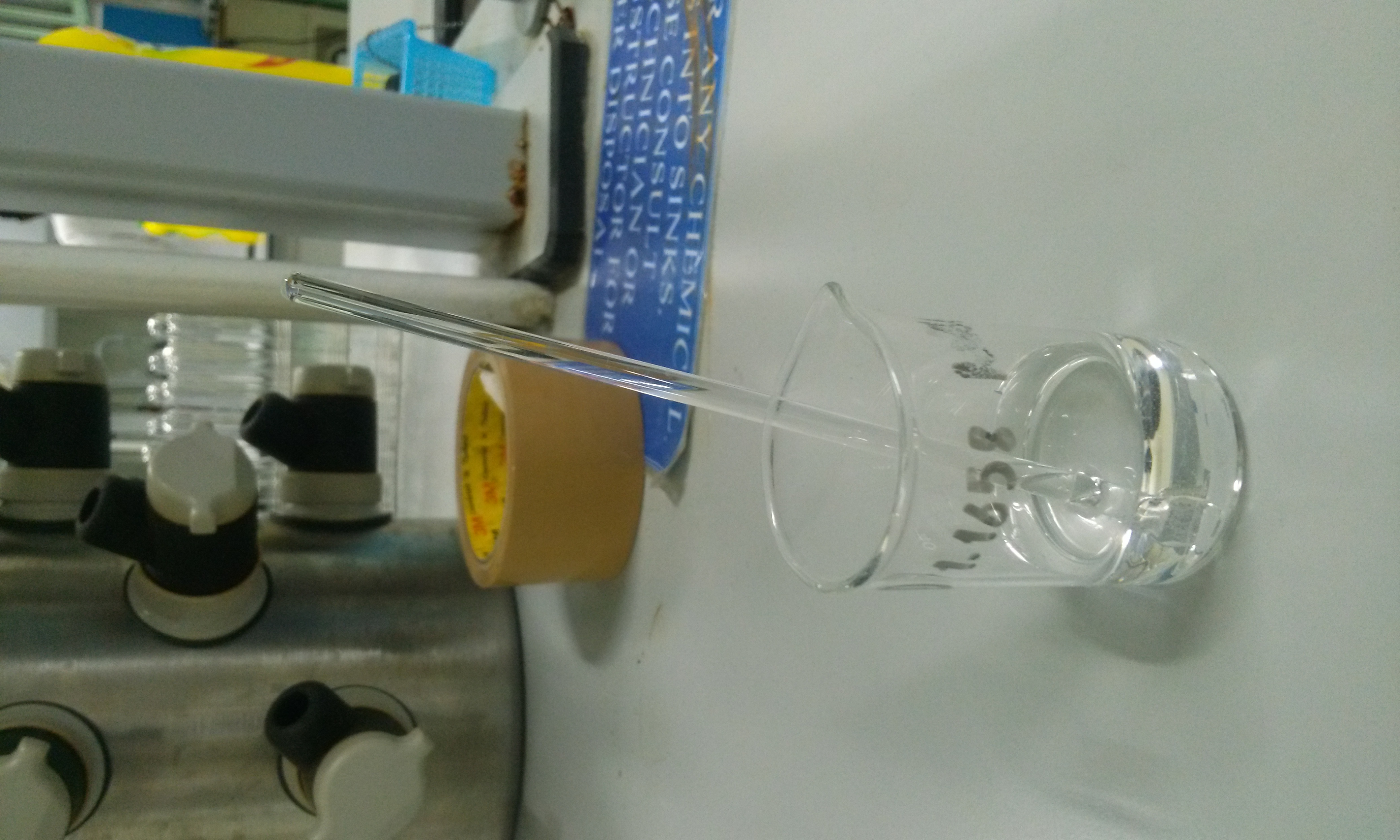Glass Rod on:
[Wikipedia]
[Google]
[Amazon]
 A glass stirring rod, glass rod, stirring rod or stir rod is a piece of
A glass stirring rod, glass rod, stirring rod or stir rod is a piece of

 A glass stirring rod, glass rod, stirring rod or stir rod is a piece of
A glass stirring rod, glass rod, stirring rod or stir rod is a piece of laboratory
A laboratory (; ; colloquially lab) is a facility that provides controlled conditions in which scientific or technological research, experiments, and measurement may be performed. Laboratory services are provided in a variety of settings: physic ...
equipment used to mix chemicals. They are usually made of solid glass, about the thickness and slightly longer than a drinking straw, with rounded ends.
Structure
Stir rods are generally made ofborosilicate
Borosilicate glass is a type of glass with silica and boron trioxide as the main glass-forming constituents. Borosilicate glasses are known for having very low coefficients of thermal expansion (≈3 × 10−6 K−1 at 20 °C), ma ...
(commonly known as Pyrex) glass or polypropylene
Polypropylene (PP), also known as polypropene, is a thermoplastic polymer used in a wide variety of applications. It is produced via chain-growth polymerization from the monomer propylene.
Polypropylene
belongs to the group of polyolefins a ...
plastic.
They are usually between 10 and 40 centimeters
330px, Different lengths as in respect to the Electromagnetic spectrum, measured by the Metre and its deriveds scales. The Microwave are in-between 1 meter to 1 millimeter.
A centimetre (international spelling) or centimeter (American spellin ...
in length and about half a centimeter in diameter.
Glass rods are created from a single length of thin glass that is then cut into smaller segments. The ends are generally rounded (for example, by flame polishing
Fire polishing, also known as flame polishing, is a method of polishing a material, usually glass or thermoplastics, by exposing it to a flame or heat. When the surface of the material briefly melts, surface tension smooths the surface. Operator sk ...
) to prevent scratching the surface of glassware during use, which may lead to cracks if the glassware is later heated. Other shapes are possible, such as a flat paddle which can be used to circulate sediment, a triangular paddle to imitate a rubber policeman
A policeman is a hand-held flexible natural-rubber or plastic scraper. The common type of it is attached to a glass rod and used in chemical laboratories to transfer residues of precipitate or solid on glass surfaces when performing gravimetric ana ...
or a round button used to crush solids.
Uses
A stirring rod is used for mixing liquids, or solids and liquids. Stir rods are used as part of proper laboratory technique when decanting supernatants because the contact helps to negate the adhesion between the side of the glassware and the supernatant that is responsible for the liquid running down the side. Using a stir rod also grants more control over the rate of flow, which is important in cases where chemicals may react violently. This process is also used to pour a large-mouthed flask or beaker into a test tube. Glass rods can also be used to induce crystallization in a recrystallization procedure, when they are used to scratch the inside surface of a test tube or beaker. They can also break up anemulsion
An emulsion is a mixture of two or more liquids that are normally immiscible (unmixable or unblendable) owing to liquid-liquid phase separation. Emulsions are part of a more general class of two-phase systems of matter called colloids. Altho ...
during an extraction.

Applications in physics
These are two classic experiments performed using glass rods.Vanishing rods experiment
This experiment introduces students to the concept of an index of refraction in a liquid. Glass rods are placed in beakers of liquid, in this case oil and water. In water, the glass rods are visible because the refractive index of water is different for water and glass. In the oil, however, the glass rods seem to disappear because they have a refractive index very similar to that of glass, so the light doesn't bend as it crosses the glass/oil interface.Electrification
Glass rods can also be used to demonstrate electrification by friction. This occurs when there are two surfaces rubbing together. In this instance, rubbing a glass rod with silk transfers negative charge from it. This effect is known as thetriboelectric effect
The triboelectric effect (also known as triboelectric charging) is a type of contact electrification on which certain materials become electrically charged after they are separated from a different material with which they were in contact. Rubb ...
and can be performed with a variety of materials. Because glass rods and silk are relatively common, they are often chosen to demonstrate this effect.
See also
*Magnetic stirrer
A magnetic stirrer or magnetic mixer is a laboratory device that employs a rotating magnetic field to cause a stir bar (or ''flea'') immersed in a liquid to spin very quickly, thus stirring it. The rotating field may be created either by a rota ...
*Rubber policeman
A policeman is a hand-held flexible natural-rubber or plastic scraper. The common type of it is attached to a glass rod and used in chemical laboratories to transfer residues of precipitate or solid on glass surfaces when performing gravimetric ana ...
* Swizzle stick
References
{{Laboratory equipment Laboratory glassware